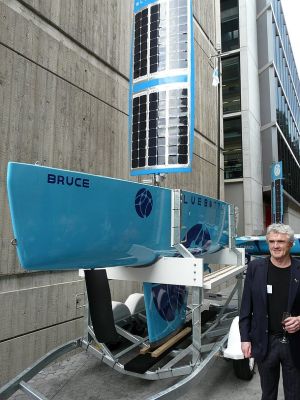Patrick Durrant | Sydney
Yesterday at the University of New South Wales, Ocius Technology launched the first prototype of their Bluebottle Stinger Unmanned Surface Vessel (USV), marking a significant milestone in the development of an autonomous ASW capability for Navy.
"Bruce" was christened before Ocius employees, academics, representatives of partners including Thales Australia, Steber International, and DST Group and former Prime Minister Bob Hawke, there in his capacity as chairman of the Ocius Technology advisory board.
In 2015, Ocius teamed with aerospace and defence electronics company Thales to win DST Group Capability Technology Demonstrator funding to develop a USV suitable for ASW.
“Our whole R&D effort has been focused on a meaningful speed of advance in all conditions while carrying and powering a payload.”
The 5.6 metre Bluebottle has been designed to carry a 105 kilogram payload which includes a winch, cable and a towed array or 'Stinger' developed by Thales. It can be launched either from land or a naval vessel and uses the energy at the surface of the ocean – solar, wind and wave power – for onboard equipment and propulsion. For more information and a company profile of Ocius Technology, see ADM's recent SME Spotlight.
Ocius Technology CEO Robert Dane said that although the company faced international competitors, some of which were better funded, he was confident that Ocius had the best product.
"Our whole R&D effort has been focused on a meaningful speed of advance in all conditions while carrying and powering a payload," he said. "This is potentially a $3.8 billion market and we have the best product which has been developed here in Australia."
Representing DST Group and speaking on behalf of Chief Defence Scientist Alex Zelinsky, Dr David Battle, head of littoral unmanned systems group, said the Ocius proposal addressed a clear gap in Defence capability and would better enable the Navy to conduct underwater surveillance in the 50 million square kilometres of ocean under its jurisdiction.
 "It ticked all the boxes of being autonomous and ASW-related which is one of the major missions for the Navy," Battle said. There's simply no way that you can control that amount of ocean with manned and crewed assets – the future belongs to vessels like this."
"It ticked all the boxes of being autonomous and ASW-related which is one of the major missions for the Navy," Battle said. There's simply no way that you can control that amount of ocean with manned and crewed assets – the future belongs to vessels like this."
Pointing at the Bluebottle, Dane said, "for the cost of one of the future submarines Australia could field 10,000 of these".
"What we are doing here today represents a new paradigm – these are like the satellites of the sea, they're out there continuously, listening constantly and, as Alan Steber (MD Steber International) said, 'there's no overtime'".
The Bluebottle Stinger USV with Ocius Technology CEO Robert Dane. Credit: ADM Patrick Durrant
At this point Hawke interjected with the wry quip: "We'll have to get the unions onto that".
He then paid a heartfelt tribute to Dane and his wife Susan who has been a staunch supporter of her husband's endeavours to date. He said as leader of the ACTU and then later as PM he had a unique opportunity to get to know Australians; how they operated, and also their spirit.
"And I want to say to you without any hesitation at all, that in that 21 year period, in terms of Australian endeavour and industrial zeal, I have never met two people more deserving of success than Robert and Susan Dane."
The next phase will see the prototype subjected to trials with a CTD program demonstration taking place in early 2018.




